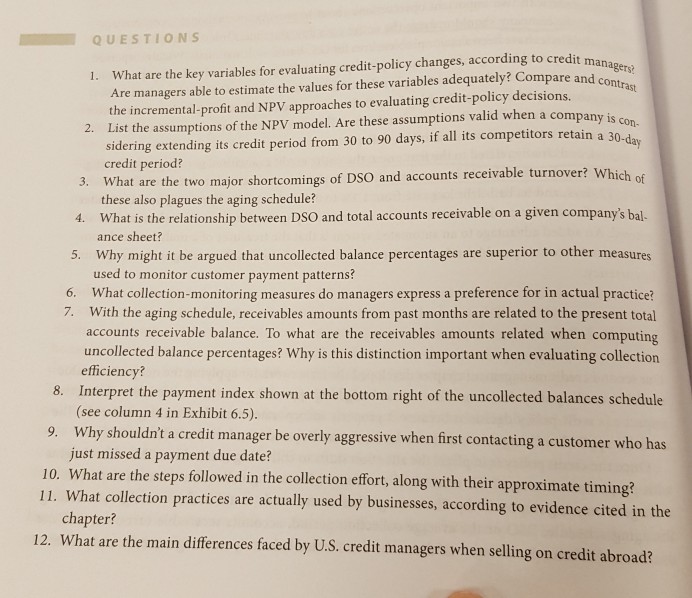Answered step by step
Verified Expert Solution
Question
1 Approved Answer
please answers # 5,6,9,11,12 QUESTIONS 1. What are the key variables for evaluating credit-policy changes, according to credit m re managers able to estimate the

please answers # 5,6,9,11,12
QUESTIONS 1. What are the key variables for evaluating credit-policy changes, according to credit m re managers able to estimate the values for these variables adequately? Compare and co the incremental-profit and NPV approaches to evaluating credit-policy decisions con- List the assumptions of the NPV model. Are these assumptions valid when a company is o 2. sidering extending its credit period from 30 to 90 days, if all its competitors retain a 30 credit period? of 3. W hat are the two major shortcomings of DSO and accounts receivable turnover? Which these also plagues the aging schedule? 4. What is the relationship between DSO and total accounts receivable on a given company's bal. ance sheet? 5. Why might it be argued that uncollected balance percentages are superior to other measures used to monitor customer payment patterns? 6. What collection-monitoring measures do managers express a preference for in actual practice? 7. With the aging schedule, receivables amounts from past months are related to the present total accounts receivable balance. To what are the receivables amounts related when computing uncollected balance percentages? Why is this distinction important when evaluating collection efficiency? 8. Interpret the payment index shown at the bottom right of the uncollected balances schedule (see column 4 in Exhibit 6.5). hy shouldn't a credit manager be overly aggressive when first contacting a customer who has just missed a payment due date? 9. W 10. What are the steps followed in the collection effort, along with their approximate timing? 11. What collection practices are actually used by businesses, according to evidence cited in the chapter? 12. What are the main differences faced by U.S. credit managers when selling on credit abroad? QUESTIONS 1. What are the key variables for evaluating credit-policy changes, according to credit m re managers able to estimate the values for these variables adequately? Compare and co the incremental-profit and NPV approaches to evaluating credit-policy decisions con- List the assumptions of the NPV model. Are these assumptions valid when a company is o 2. sidering extending its credit period from 30 to 90 days, if all its competitors retain a 30 credit period? of 3. W hat are the two major shortcomings of DSO and accounts receivable turnover? Which these also plagues the aging schedule? 4. What is the relationship between DSO and total accounts receivable on a given company's bal. ance sheet? 5. Why might it be argued that uncollected balance percentages are superior to other measures used to monitor customer payment patterns? 6. What collection-monitoring measures do managers express a preference for in actual practice? 7. With the aging schedule, receivables amounts from past months are related to the present total accounts receivable balance. To what are the receivables amounts related when computing uncollected balance percentages? Why is this distinction important when evaluating collection efficiency? 8. Interpret the payment index shown at the bottom right of the uncollected balances schedule (see column 4 in Exhibit 6.5). hy shouldn't a credit manager be overly aggressive when first contacting a customer who has just missed a payment due date? 9. W 10. What are the steps followed in the collection effort, along with their approximate timing? 11. What collection practices are actually used by businesses, according to evidence cited in the chapter? 12. What are the main differences faced by U.S. credit managers when selling on credit abroadStep by Step Solution
There are 3 Steps involved in it
Step: 1

Get Instant Access to Expert-Tailored Solutions
See step-by-step solutions with expert insights and AI powered tools for academic success
Step: 2

Step: 3

Ace Your Homework with AI
Get the answers you need in no time with our AI-driven, step-by-step assistance
Get Started


